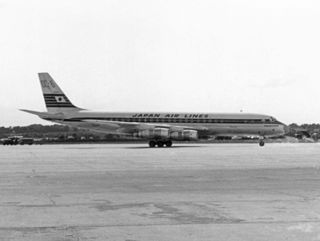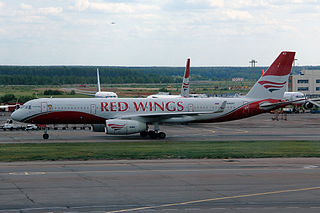
The McDonnell Douglas DC-10 is an American tri-jet wide-body airliner manufactured by McDonnell Douglas. The DC-10 was intended to succeed the DC-8 for long-range flights. It first flew on August 29, 1970; it was introduced on August 5, 1971, by American Airlines.

United Airlines Flight 232 was a regularly scheduled United Airlines flight from Stapleton International Airport in Denver to O'Hare International Airport in Chicago, continuing to Philadelphia International Airport. On July 19, 1989, the DC-10 serving the flight crash-landed at Sioux City, Iowa, after suffering a catastrophic failure of its tail-mounted engine, which led to the loss of many flight controls. Of the 296 passengers and crew on board, 112 died during the accident, while 184 people survived. The crash was the fifth-deadliest one involving the DC-10, behind Turkish Airlines Flight 981, American Airlines Flight 191, Air New Zealand Flight 901, and UTA Flight 772. Despite the deaths, the accident is considered a prime example of successful crew resource management because of the large number of survivors and the manner in which the flight crew handled the emergency and landed the airplane without conventional control.

American Airlines Flight 96 was a regular domestic flight operated by American Airlines from Los Angeles to New York via Detroit and Buffalo. On June 12, 1972, the left rear cargo door of the McDonnell Douglas DC-10-10 operating the flight blew open and broke off en route between Detroit and Buffalo above Windsor, Ontario; the accident is thus sometimes referred to as the Windsor incident, although for the NTSB it is an accident, therefore not an incident.

Southwest Airlines Flight 1248 was a scheduled passenger flight from Baltimore, Maryland, to Chicago, Illinois, continuing on to Salt Lake City, Utah, and then to Las Vegas, Nevada. On December 8, 2005, the airplane slid off a runway at Chicago-Midway while landing in a snowstorm and crashed into automobile traffic, killing a six-year-old boy.

S7 Airlines Flight 778(RU778/SBI778) was an Airbus A310-300 on a scheduled domestic passenger flight, flying from Moscow Domodedovo to Irkutsk, when it crashed upon landing at Irkutsk International Airport at 07:44 local time on 9 July 2006, killing 125 people. The plane overshot the runway, sliding over several hundred metres of wet runway and grass. It crashed through a concrete barricade, hit a group of private garages and burst into flames. Television pictures showed smoking ruins of the Airbus with only the tail section intact. It took two hours for local firefighters from five different fire stations to extinguish the blaze.

Trans World Airlines (TWA) Flight 159 was a regularly scheduled passenger flight from New York City to Los Angeles, California, with a stopover in Cincinnati/Northern Kentucky International Airport, Kentucky, that crashed after an aborted takeoff from Cincinnati on 6 November 1967. The Boeing 707 attempted to abort takeoff when the copilot became concerned that the aircraft had collided with a disabled DC-9 on the runway. The aircraft overran the runway, struck an embankment and caught fire. One passenger died as a result of the accident.

TAM Transportes Aéreos Regionais Flight 402 was a scheduled domestic flight from São Paulo–Congonhas International Airport in São Paulo, Brazil to Recife International Airport in Recife via Santos Dumont Airport in Rio de Janeiro. On 31 October 1996, at 8:27 (UTC-2), the starboard engine of the Fokker 100 operating the route reversed thrust while the aircraft was climbing away from the runway at Congonhas. The aircraft stalled and rolled beyond control to the right, then struck two buildings and crashed into several houses in a heavily populated area only 25 seconds after takeoff. All 95 people on board were killed, as well as another 4 on the ground. It is the fourth deadliest accident in Brazilian aviation history, the second at the time. It is also the deadliest aviation accident involving a Fokker 100.

Lufthansa Flight 2904 was an Airbus A320-200 flying from Frankfurt, Germany to Warsaw, Poland that overran the runway at Okęcie International Airport on 14 September 1993.

TAM Airlines Flight 3054 (JJ3054/TAM3054) was a regularly scheduled domestic passenger flight from Porto Alegre to São Paulo, Brazil. On the evening of July 17, 2007, the Airbus A320-233 executing the flight overran runway 35L at São Paulo during moderate rain and crashed into a nearby TAM Express warehouse adjacent to a Shell filling station. The plane exploded on impact, killing all 187 passengers and crew on board and 12 people on the ground. The crash surpassed Gol Transportes Aéreos Flight 1907 as the deadliest aviation accident in Brazilian territory and in South American history, and remains the deadliest aviation accident involving the A320 proper worldwide, and the second-deadliest air disaster involving the A320 family, surpassed by the bombing of Metrojet Flight 9268, an A321-231, which crashed in Egypt in October 2015 with 224 fatalities.

FedEx Express Flight 14 was a scheduled cargo flight from Singapore to Newark, New Jersey, via Malaysia, Taiwan, and Alaska. On July 31, 1997, the aircraft flying this route crashed during landing on its final segment at Newark International Airport (EWR), catching fire as it flipped upside down, injuring all five people on board.

China Airlines Flight 605 was a daily non-stop flight departing from Taipei at 6:30 a.m. and arriving at Kai Tak Airport in Hong Kong at 7:00 a.m. local time. On November 4, 1993, the plane went off the runway while landing during a storm. It was the first hull loss of a Boeing 747-400.

Japan Airlines Flight 446 was a Japan Airlines flight from Sheremetyevo International Airport of Moscow, Russian SFSR, Soviet Union to Tokyo International Airport in Ōta, Tokyo, Japan.

Trans World Airlines Flight 800 was an international scheduled passenger service from Kansas City, Missouri to Cairo, Egypt via Chicago, New York City, Paris, Milan, Rome, and Athens. The Boeing 707 crashed during take off on runway 25 at Leonardo da Vinci–Fiumicino Airport, Rome at 13:09 GMT on a flight to Athens International Airport, Greece on 23 November 1964.
Several aviation incidents and accidents have occurred in which the control surfaces of the aircraft became disabled, often due to failure of hydraulic systems or the flight control system. Other incidents have occurred where controls were not functioning correctly prior to take-off, either due to maintenance or pilot error, and controls can become inoperative from extreme weather conditions. Aircraft are not designed to be flown in such circumstances, however a small number of pilots have had some success in flying and landing aircraft with disabled controls.

On April 4, 1955, a United Airlines Douglas DC-6 named Mainliner Idaho crashed shortly after taking off from Long Island MacArthur Airport, in Ronkonkoma, Islip, New York, United States.
In aeronautics, loss of control (LOC) is the unintended departure of an aircraft from controlled flight, and is a significant factor in several aviation accidents worldwide and the leading cause of jet fatalities worldwide. Loss of control may be the result of mechanical failure, external disturbances, aircraft upset conditions, or inappropriate crew actions or responses.

Red Wings Airlines Flight 9268 was a Tupolev Tu-204-100 passenger jet that on 29 December 2012 crashed on landing at Moscow Vnukovo Airport, Russia, following a repositioning flight from Pardubice Airport, Czech Republic. There were no passengers on board, but 5 of the 8 crew members were killed when the aircraft hit a ditch and highway structures after overrunning the runway.

Fly Jamaica Airways Flight 256 was a scheduled international passenger flight from Cheddi Jagan International Airport in Guyana to Toronto Pearson International Airport in Canada. The Boeing 757 aircraft serving the flight suffered a technical fault on 9 November 2018, forcing its return and resulting in a runway excursion on landing. This caused significant damage to the aircraft and one passenger fatality.


















